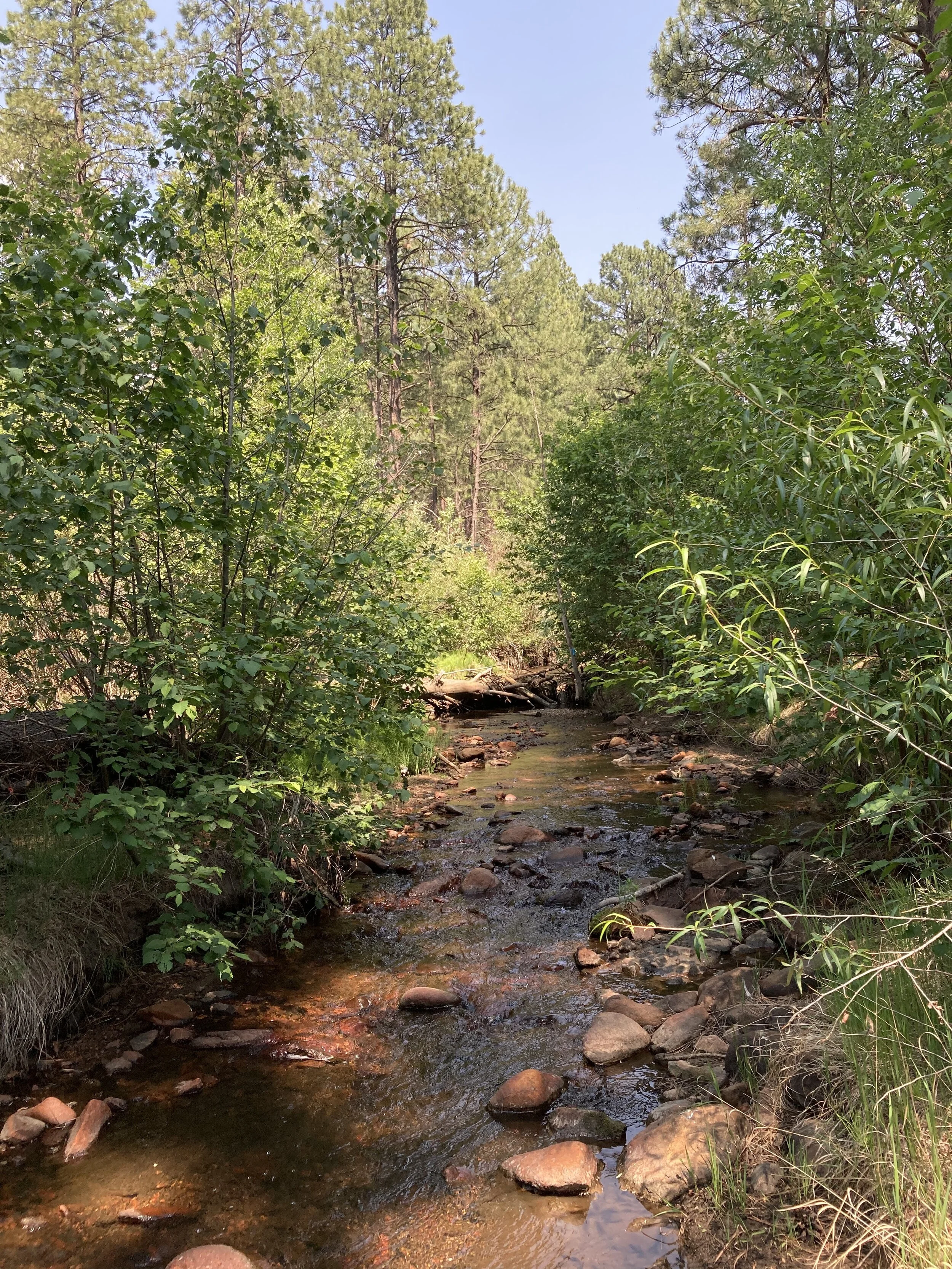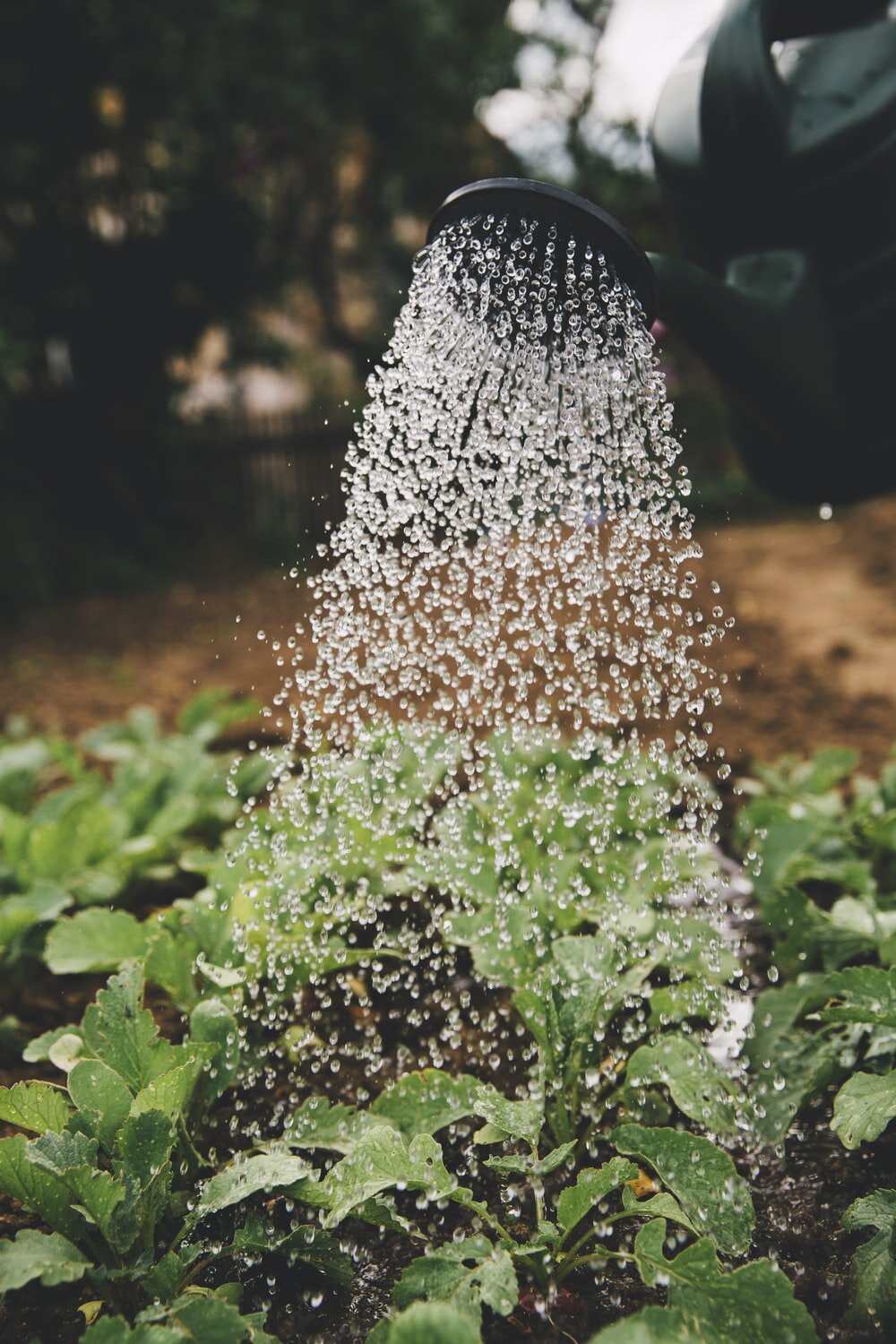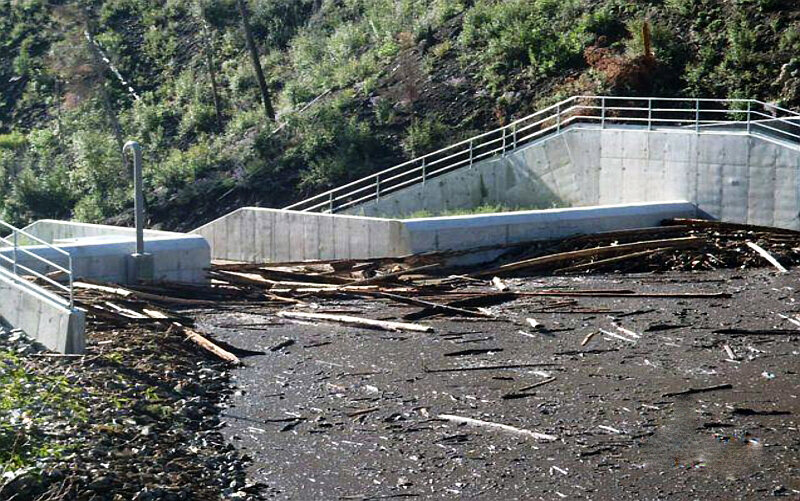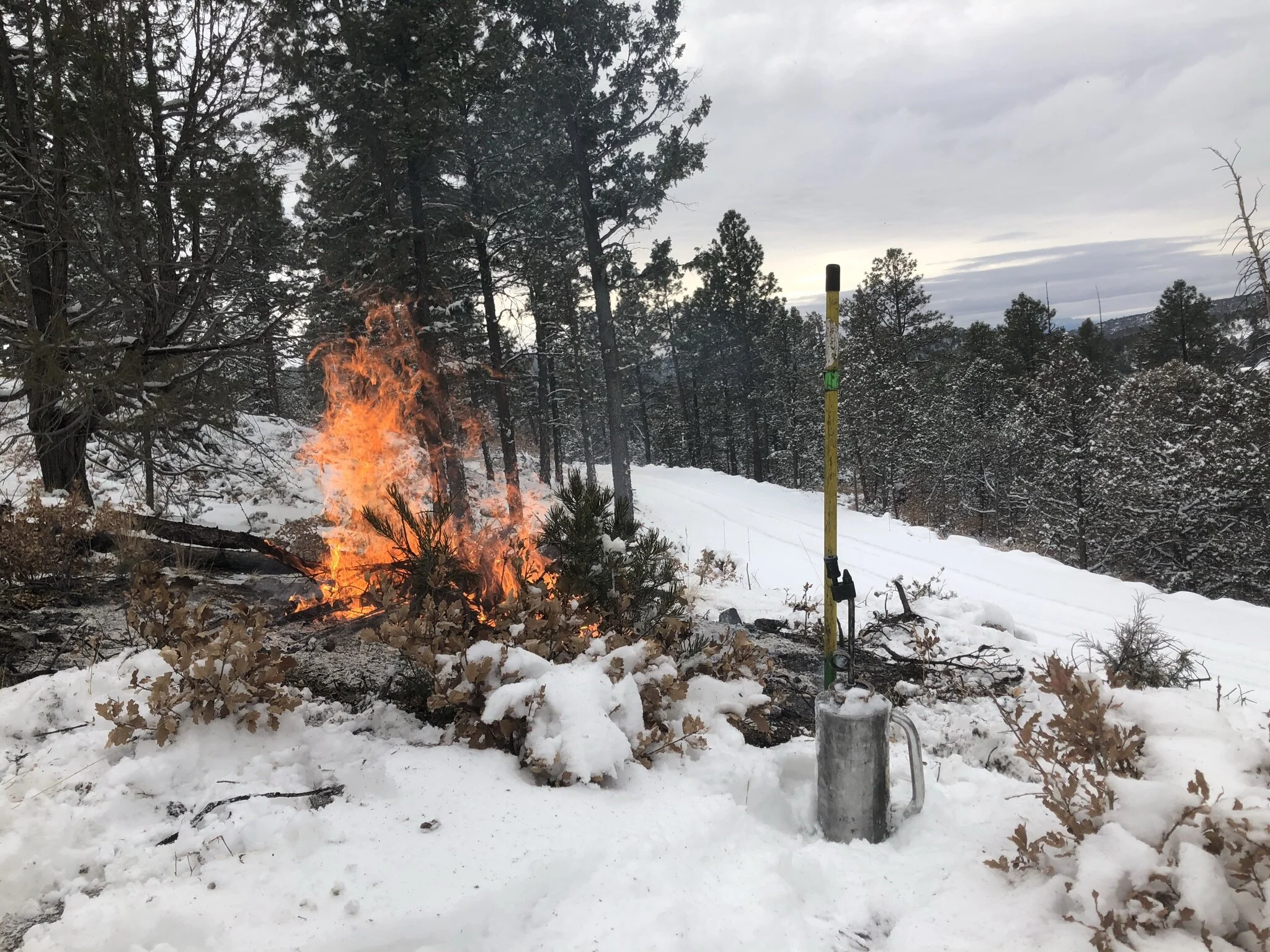One Watershed
What is a watershed?
You may start your day with a hot cup of coffee, or tea, or perhaps a cool glass of water with a slice of lemon to invigorate and wake you. You put your dirty cup in the dishwasher and start the cycle before hopping in the shower to get ready for the day. Toilets flushing, showers running, dishwashers washing, gardens being watered - turning on the tap and expecting that clean potable water will come out is second nature.
So, where does all of this water come from?
Prior to the 1950s, 100% of Santa Fe’s water came from surface flow off of the surrounding land – the watershed. The watershed reaches from Lake Peak to Cochiti, but the northern-most portion is what has always supplied Santa Fe. The city was founded alongside the Santa Fe River and spent the next 400 years growing around this watercourse and associated water supply. City planners and engineers dammed the river to create two reservoirs, caching water upstream for release when the weather warmed and the flow slowed.
17,384 acres
~40% of Santa Fe’s drinking water
Pictured: McClure Reservoir and earthen dam, built 1926
These days, Santa Fe continues to source a significant percentage of its water from the forested municipal watershed – 40% on average. The groundwater supply and the city wellfield are also dependent on recharge from surface flows, stormwater surges, and other releases which ultimately come from the watershed. The Santa Fe River remains the cheapest, cleanest, renewable source of drinking water for the city and surrounding county. However, this river and the watershed which feeds it are at risk.
What is the risk?
The city has continued to grow and its water supply infrastructure has aged. Both McClure and Nichols earthen dams are:
nearly 100 years old
rated by the Dam Safety Bureau as being in “poor” condition
at risk of breaking under additional pressure
in a high wildfire risk area
Were one of these dams to break, it would flood downtown Santa Fe and neighborhoods along the river corridor. The watershed itself is also at risk. Heavy rains can trigger debris flows – a phenomena where topsoil and other sediment dislodges and is washed down the mountain in slushy, muddy, viscous rivers. This sediment separates and settles out once the water stops moving, such as in a reservoir. Studies have shown that less than three hundredths of an inch of rain per minute (~1.7 inches per hour) could trigger debris flows, particularly after a wildfire, and fill the Nichols and McClure reservoirs with sediment, rendering the emergency release valve unusable.
A fire in the watershed would only compound this risk, flames scorching the surrounding soils and baking them into a hydrophobic crust with no stabilizing grasses and forbs. This damaged soil sheds water mixed with ash and debris rather than absorbing the rainwaters (videos of debris flows in New Mexico: Santa Clara Pueblo debris flow, 2013 and Cochiti Canyon debris flow, 2011). It may also contain harmful components such as soil black carbon, a resultant of soil scorching which can absorb contaminants such as the heavy metals lead and chromium, disinfection byproducts (DBPs), and dissolved organic carbon (DOC) which can lead to the development of carcinogenic compounds during the water treatment process. These components may be deposited into watersheds and stream systems during post-fire debris flows and then make their way into reservoirs and drinking water (Manuel Lopez, 2017; Chow et al, 2018). A recent study revealed that over 10% of river systems in the western US have been detrimentally impacted by wildfires in the past 30 years, and that trend is increasing; this damage is cumulative, and impacts both watershed function and water quality (Ball et al, 2021).
Our mountains and forests provide clean drinking water for over 87,000 people, naturally filtering it and sending it down to the city in flowing rivers and trickling streams. However, these forests may also pose a risk to the watershed they support. Overstocking, or an overabundance of trees compared to the historical ecological conditions and what the landscape can realistically support, stresses the forest through competition for resources and leads to conditions which are ripe for fueling catastrophic wildfire. A small 2016 wildfire, the McClure Fire, burned under 10 acres in the Pecos Wilderness above McClure Reservoir. While fire managers considered allowing it to continue burning to reduce surface fuels, they ultimately decided that “the risk of a large, high-severity fire in the Watershed was too high to do anything other than suppress it” (McClure Fire Briefing, July 6, 2016).
81% of the municipal watershed is subject to high-severity torching and crown fire under typical summer wildfire conditions, corresponding to those areas which lacked land management treatments.
In a worst-case scenario, debris flows would fill and overload the higher-elevation McClure reservoir, saturating the earthen dam and causing it to fail and ultimately break. A breach in the dam would send millions of gallons of silty water gushing down the Santa Fe River canyon, overwhelming Nichols reservoir and flooding significant portions of the city while destroying homes and infrastructure. The granitic (made up of granite) soils surrounding both reservoirs are less stable than other soil types, which makes them more susceptible to movement and dislodging even without a wildfire to exacerbate the risk. Depending on the amount of precipitation received, 40-95% of the watershed would be at elevated risk of debris flows and destructive flooding if a wildfire were to occur within its boundaries (Manuel Lopez, 2017). Debris flows, high-intensity wildfire, and the subsequent uncertainty of municipal water availability all threaten the social values Santa Feans hold dear – their homes, businesses, cultural monuments and traditions, recreational opportunities, and tourism and economic growth. The inherent values of the watershed, its landscapes, plants, and wildlife like the synecdochic Mexican Spotted Owl, are also values which are threatened by natural disaster, although they are not often assigned monetary worth. With these many values at risk to wildfire and post-fire consequences, figuring out how to ensure the resiliency of that watershed is a major challenge for land managers, the City Water Division, and others.
What is being done to protect the watershed?
It is important to consider every angle of wildfire readiness, before, during, and after a fire happens. Water management companies work with, and fund activities by, federal and nonprofit organizations such as USFS, USGS, and the Forest Stewards Guild to implement forest treatments which keep ecosystems and their water supply healthy. These collaborations often include creation of a plan which addresses all aspects of wildfire mitigation: reduce fire risks beforehand while also developing a response protocol for the eventuality of fire. Preventative measures ultimately reduce risk of (and cost of recovery from) fire damage, as well as help ensure continued health and wealth of the water supply.
“The land... evolved with regularly-occurring surface fire as part of its natural ecological cycle.”
Much of the southwestern United States is composed of fire-adapted landscapes, meaning that the land on which we live and love evolved with regularly-occurring surface fire as part of its natural ecological cycle. This cycle of disturbance is important for supporting a healthy forest: it reduces the amount of fine flammable surface fuel on the forest floor, prevents forests from becoming overstocked by eliminating seedlings growing under a live tree canopy, and encourages soil nutrient cycling as well as the creation of diverse wildlife habitat. As Alan Hook (City of Santa Fe Water) states, “a healthy forest means a healthy watershed”, meaning the best thing that can be done to protect the water is to protect the forest, and protecting the forest means restoring it to a more disturbance-resilient condition. Management strategies, including stand thinning and planned broadcast burning, can restore a natural forest structure while promoting the success of young, fast-growing plants that reduce surface runoff and therefore increase water quality. Areas which have been treated to reduce wildfire risk are shown to burn at lower severity and are less likely to experience debris flows and other sediment shedding following a precipitation event. Overall, fire-resilient and stable forest ecosystems provide reliable quality and quantity of available drinking water, critical for city planning and the longevity of our desert dwelling.
Forest restoration and resiliency through responsible land management
It is tempting to think of forest restoration as something which happens only in the forested areas which surround our homes and infrastructure, those areas in the lower-elevation ponderosa and piñon pine-dominated Wildland Urban Interface (WUI). The reality is that nearly 60% of the municipal watershed is contained within the high-elevation mixed conifer Pecos Wilderness. This wilderness area is rated as being at high risk of experiencing high-severity fire if left untreated. Luckily, we have made progress in the past 20 years:
- over 6,500 acres in the lower watershed, that area surrounding the WUI, were treated between 2003 and 2009, and
- the watershed collaborative published a 20-year Santa Fe Municipal Water Plan in 2010, revised in 2013 and 2017.
This plan outlines how the city has and will treat the upper wilderness area, as well as maintain the already-accomplished lower watershed treatments, while protecting sensitive species and managing for smoke impacts to the community. The challenge presented by risks to Santa Fe’s water supply is mighty, but we have a foundation of land stewardship and a plan to carry that work into the future to ensure we rise to meet the challenge.
Mechanical Thinning
These treatments, completed in staggered stages to allow the landscape time to adjust between entries, reduced the stand stocking in the watershed from ~1,200 trees per acre to
90-120 trees per acre.
Nearly 6,000 acres in the lower watershed (around Nichols Reservoir and up to McClure Reservoir) have been mechanically thinned or masticated since 2003. The ecologically-appropriate stand density for these piñon-juniper and ponderosa-dominated areas is ~50 trees per acre, a number which will be achieved through the continual use of prescribed broadcast burning. Land managers plan on monitoring the piñon-juniper woodlands around Nichols reservoir to evaluate their condition and determine whether additional thinning and prescribed burning is needed in the future.
Mechanical thinning is a good option for treating some lands, especially those around the wildland-urban interface where homes and structures exist. However, it is limited by road access, landscape type and slope, and financial/time constraints due to the amount of human power needed to accomplish mechanical treatment. Prescribed burning (and, where applicable, managed wildfire) is another treatment tool available to land managers which can be used to treat vast swaths of land on an accelerated timeline. If planned correctly, it can effectively reduce surface fuels, thin the forest canopy, and restore the forest to a more fire-resilient mosaic pattern. Like many treatments, prescribed fire is most effective when given the opportunity for multiple entries, staggered several years apart – meaning that the same plot of land is intentionally burned at low- to moderate-severity multiple times. Beyond fire-prevention, prescribed burning also jumpstarts nutrient cycling, making for more fertile soil, and has been shown to improve water quality and treatability by reducing harmful chemical compounds in the soil (Chow et al, 2018). As the Santa Fe National Forest puts it, “In the coming years, forest restoration will be our primary goal with a heavy emphasis on returning frequent-fire systems to more natural conditions. Uncharacteristic fire remains one of our greatest concerns.”
Prescribed Burning
The municipal watershed plan outlines the goal of broadcast burning 1,000 acres in the lower watershed every year, maintaining low surface fuel levels and continually raising the base canopy height of the trees by maintenance burning the entire lower watershed every 7 years. The existing treatments aim to allow fire suppression personnel to contain a wildfire within the lower watershed to 10 acres of high-intensity fire and 20 acres of low intensity fire. The potential for a wildfire to catch in the watershed is still there, but the chance of it becoming a widespread catastrophic fire is reduced.
Treatments become trickier in the upper watershed, that area above McClure Reservoir which is primarily comprised of wilderness-designated land; the landscape is steep and inaccessible by road, and wilderness designation means that mechanical equipment, even chainsaws, cannot operate in the area without a special permit. The ecology of the wilderness also presents a challenge: spruce-fir forests, typically found >10,000 feet elevation, do not exhibit the same frequent-fire adapted characteristics of the lower piñon-juniper and mixed-conifer forests, and therefore cannot be treated in the same manner with thinning and prescribed burning. These trees are between 150 and 300 years old and typically burn every 100-300 years in a stand-replacing fire, rendering the treatments implemented in the lower watershed inappropriate for the upper watershed. The municipal water plan aims to treat 2,900 acres of mixed-conifer (<10,000 feet) wilderness with multiple entries of prescribed fire, reducing the risk of catastrophic wildfire in that portion of the upper watershed. As of now the city does not plan on treating the highest-elevation 4,100 acres of spruce-fir forest.
Water Storage Improvements
City of Santa Fe Water has created a hazard mitigation plan; reservoir infrastructure improvements, including preventing dam failure and flooding within the watershed, are two items which have been assigned notable importance. The current plan for autumn 2021 is to empty Nichols reservoir and repair the dam’s outlet conduit once funding is secured – a project which should take approximately 4 months and comes with a $10 million dollar price tag. McClure dam will require the same treatment in the next few years. These proactive steps to improve the condition of the city’s water storage are expensive but represent a first step in ensuring these man-made resources are more resilient and prepared for an uncertain water future. The city’s water division is also working with the State of New Mexico on a source water protection plan which lays the groundwork for protecting Santa Fe’s potable water from chemical leaching and industrial activity.
Like a well-planned retirement account, it is fiscally prudent for beneficiaries of the Santa Fe watershed to invest in the protection of their ecosystem services which will support them long into the future.
Preventative forest treatment and landscape restoration makes sense for the community financially, as well. 2017 estimates by the city’s water division found that estimated combined costs for fire suppression and rehabilitation within the watershed plus the cost of restoring reservoir functionality following a post-fire debris flow event could top $100 million. This price tag is likely a low estimate as it excludes the cost of damage to the Canyon Road Water Treatment Plant, increases in water utility operating and treatment costs, and impacts to the economy from loss of tourism income. According to a 2019 Core Logic report, the cost of reconstruction for Santa Fe’s highest-risk structures could top $7 billion. In comparison, the estimated cost to treat and maintain forests within the municipal watershed is $5.1 million over a 20 year span.
The bottom line: for every $1.00 invested in fuel and resilience treatments, the Santa Fe community sees a return of ~$1.55 in the form of prevented air quality impacts, recreational losses, structure damage and source water losses via a destructive watershed wildfire.
“Fire knows no boundaries; management plans shouldn’t either.”
At the end of the day, it is imperative that private, state, federal, and sovereign landowners work together to create plans for preventing and mitigating severe fire effects and to implement cross-jurisdiction landscape restoration treatments. By bringing together different groups and companies through coalitions, collaboratives, and partnerships, the boundaries by which management plans are limited grow, enabling communities to be better prepared for wildfire and other watershed disturbances.
What can I do to get involved?
Curious to get involved after learning about how our drinking water is tied to forest health?
Just like reading the morning news, the most impactful way that community members can get involved in the health of their watershed is to be informed.
Read news stories and releases about water supply
Research the science and theory behind forest health
Support the forest restoration projects happening in our backyard
The Greater Santa Fe Fireshed Coalition publishes information on wildfire mitigation projects as well as wildfire preparedness tips for residents. The City of Santa Fe has a webpage which provides background information on the watershed, its history, and the ways in which the city plans to protect and invest in it. The Santa Fe National Forest, where ~15,500 acres of the municipal watershed resides, is a major partner in implementing forest restoration treatments, including the collaborative Santa Fe Mountains Landscape Resiliency Project.
Read the latest research on how forest health is connected to water health in the USDA report Forests to Faucets. The US Forest Service has also created a StoryMap for interactive learning. You can learn from and support organizations which strive to protect source water and water sources such as Carpe Diem West. Watch the recent special from New Mexico In Focus discussing forest conditions on the 10-year anniversary of the Las Conchas fire.
If you are a homeowner or renter who lives in the WUI, you can also be part of the forest restoration solution by taking preventative steps to reduce the wildfire risk on your own property. Just as wildfire does not recognize boundaries and land ownership designations, we as a community need to work together to treat the land as one cohesive landscape and protect it appropriately. You may find helpful resources through the Fire Adapted New Mexico Learning Network, including a blog post all about home and property wildfire hardening. The City of Santa Fe also provides wildfire preparedness information and opportunities for landowner assistance.
Still want to learn more?
Check out these reports, plans, and sources:














